headlights Lancia Ypsilon 2016 Owner handbook (in English)
[x] Cancel search | Manufacturer: LANCIA, Model Year: 2016, Model line: Ypsilon, Model: Lancia Ypsilon 2016Pages: 200, PDF Size: 4.53 MB
Page 116 of 200
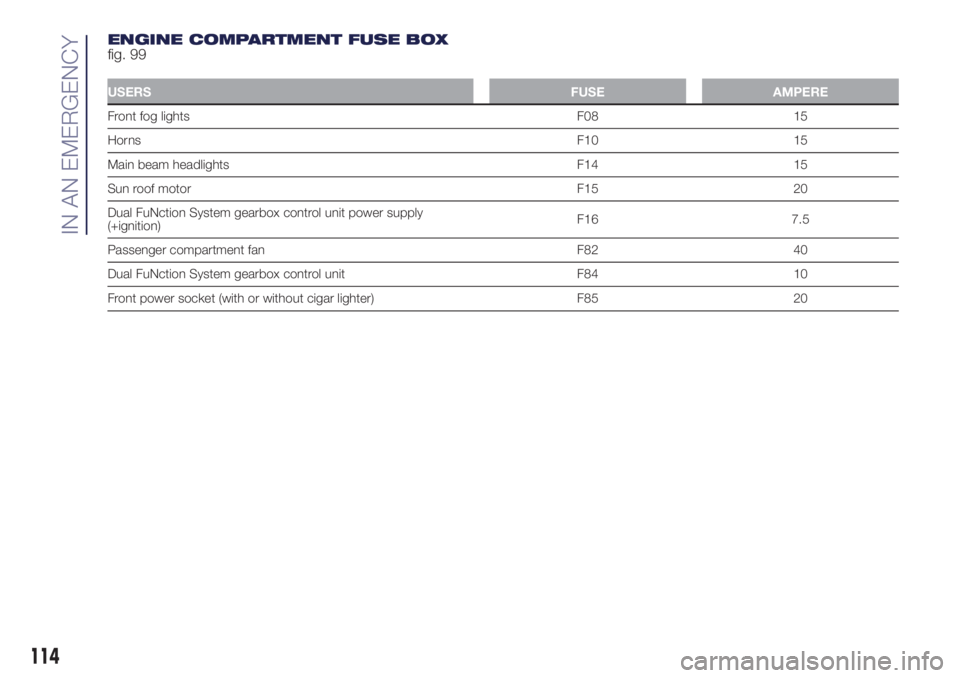
ENGINE COMPARTMENT FUSE BOX
fig. 99
USERSFUSE AMPERE
Front fog lights F08 15
HornsF10 15
Main beam headlights F14 15
Sun roof motor F15 20
Dual FuNction System gearbox control unit power supply
(+ignition)F16 7.5
Passenger compartment fan F82 40
Dual FuNction System gearbox control unit F84 10
Front power socket (with or without cigar lighter) F85 20
114
IN AN EMERGENCY
Page 130 of 200
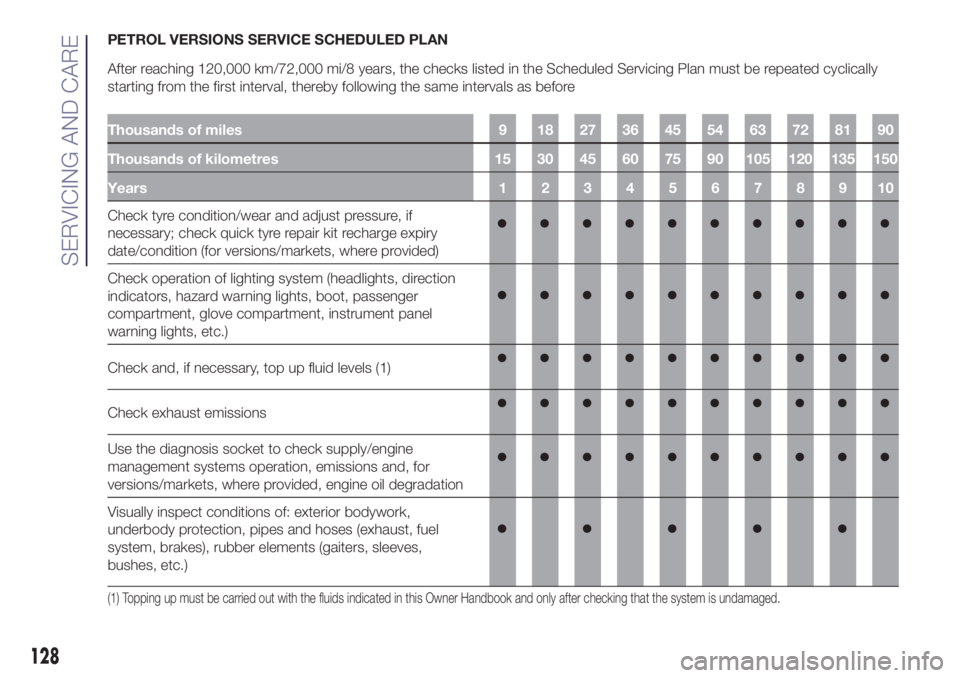
PETROL VERSIONS SERVICE SCHEDULED PLAN
After reaching 120,000 km/72,000 mi/8 years, the checks listed in the Scheduled Servicing Plan must be repeated cyclically
starting from the first interval, thereby following the same intervals as before
Thousands of miles 9 18 27 36 45 54 63 72 81 90
Thousands of kilometres 15 30 45 60 75 90 105 120 135 150
Years12345678910
Check tyre condition/wear and adjust pressure, if
necessary; check quick tyre repair kit recharge expiry
date/condition (for versions/markets, where provided)
Check operation of lighting system (headlights, direction
indicators, hazard warning lights, boot, passenger
compartment, glove compartment, instrument panel
warning lights, etc.)
Check and, if necessary, top up fluid levels (1)
Check exhaust emissions
Use the diagnosis socket to check supply/engine
management systems operation, emissions and, for
versions/markets, where provided, engine oil degradation
Visually inspect conditions of: exterior bodywork,
underbody protection, pipes and hoses (exhaust, fuel
system, brakes), rubber elements (gaiters, sleeves,
bushes, etc.)
(1) Topping up must be carried out with the fluids indicated in this Owner Handbook and only after checking that the system is undamaged.
128
SERVICING AND CARE
Page 135 of 200
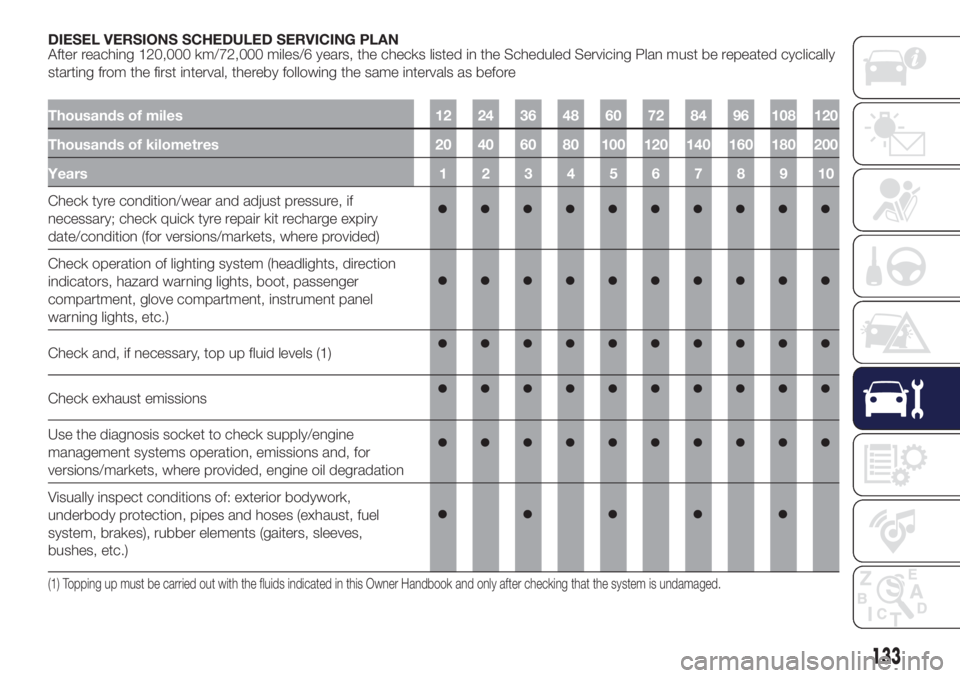
DIESEL VERSIONS SCHEDULED SERVICING PLAN
After reaching 120,000 km/72,000 miles/6 years, the checks listed in the Scheduled Servicing Plan must be repeated cyclically
starting from the first interval, thereby following the same intervals as before
Thousands of miles 12 24 36 48 60 72 84 96 108 120
Thousands of kilometres 20 40 60 80 100 120 140 160 180 200
Years12345678910
Check tyre condition/wear and adjust pressure, if
necessary; check quick tyre repair kit recharge expiry
date/condition (for versions/markets, where provided)
Check operation of lighting system (headlights, direction
indicators, hazard warning lights, boot, passenger
compartment, glove compartment, instrument panel
warning lights, etc.)
Check and, if necessary, top up fluid levels (1)
Check exhaust emissions
Use the diagnosis socket to check supply/engine
management systems operation, emissions and, for
versions/markets, where provided, engine oil degradation
Visually inspect conditions of: exterior bodywork,
underbody protection, pipes and hoses (exhaust, fuel
system, brakes), rubber elements (gaiters, sleeves,
bushes, etc.)
(1) Topping up must be carried out with the fluids indicated in this Owner Handbook and only after checking that the system is undamaged.
133
Page 138 of 200
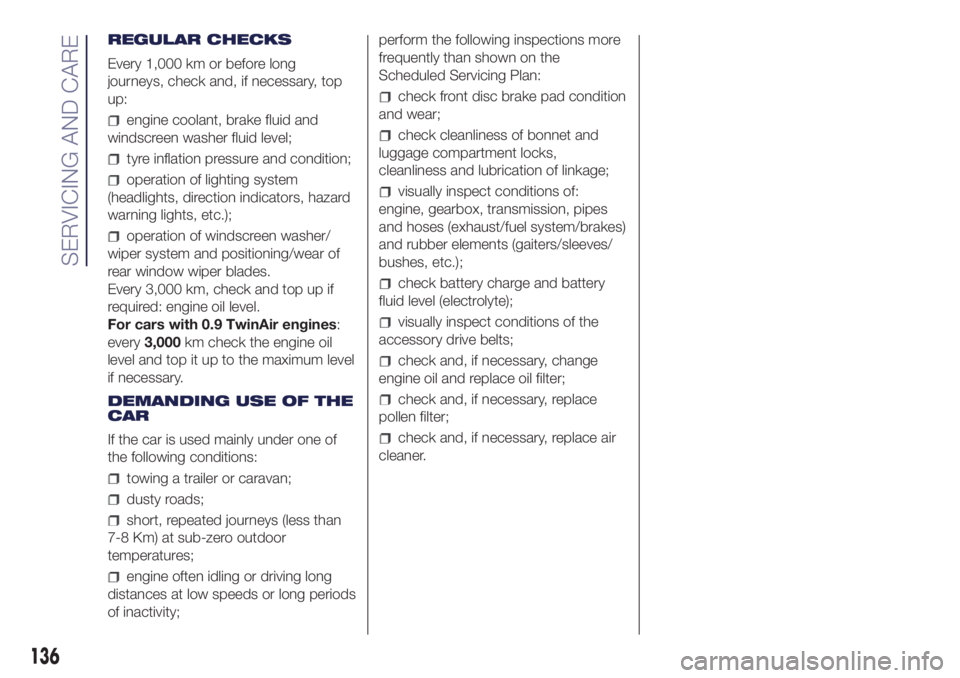
REGULAR CHECKS
Every 1,000 km or before long
journeys, check and, if necessary, top
up:
engine coolant, brake fluid and
windscreen washer fluid level;
tyre inflation pressure and condition;
operation of lighting system
(headlights, direction indicators, hazard
warning lights, etc.);
operation of windscreen washer/
wiper system and positioning/wear of
rear window wiper blades.
Every 3,000 km, check and top up if
required: engine oil level.
For cars with 0.9 TwinAir engines:
every3,000km check the engine oil
level and top it up to the maximum level
if necessary.
DEMANDING USE OF THE
CAR
If the car is used mainly under one of
the following conditions:
towing a trailer or caravan;
dusty roads;
short, repeated journeys (less than
7-8 Km) at sub-zero outdoor
temperatures;
engine often idling or driving long
distances at low speeds or long periods
of inactivity;perform the following inspections more
frequently than shown on the
Scheduled Servicing Plan:
check front disc brake pad condition
and wear;
check cleanliness of bonnet and
luggage compartment locks,
cleanliness and lubrication of linkage;
visually inspect conditions of:
engine, gearbox, transmission, pipes
and hoses (exhaust/fuel system/brakes)
and rubber elements (gaiters/sleeves/
bushes, etc.);
check battery charge and battery
fluid level (electrolyte);
visually inspect conditions of the
accessory drive belts;
check and, if necessary, change
engine oil and replace oil filter;
check and, if necessary, replace
pollen filter;
check and, if necessary, replace air
cleaner.
136
SERVICING AND CARE
Page 148 of 200

rinse well with water and dry with a
jet of air or a chamois.
Dry the less visible parts (e.g. door
frames, bonnet, headlight frames etc.)
with special care, as water may
stagnate more easily in these areas.
The car should not be taken to a closed
area immediately, but left outside so
that residual water can evaporate.
Do not wash the car after it has been
left in the sun or with the bonnet hot:
this may alter the shine of the
paintwork.
Exterior plastic parts must be cleaned
in the same way as the rest of the
vehicle.
Avoid parking under trees; the resin
dropped by trees makes the paintwork
go opaque and increases the possibility
of corrosion.
IMPORTANT Bird droppings must be
washed off immediately and thoroughly
as the acid they contain is particularly
aggressive.
66)8)
Windows
Use specific detergents and clean
cloths to prevent scratching or altering
the transparency.IMPORTANT Wipe the rear window
inside gently with a cloth following the
direction of the filaments to avoid
damaging the heating device.
Front headlights
Use a soft cloth soaked in water and
detergent for washing cars.
IMPORTANT Never use aromatic
substances (e.g. petrol) or ketones (e.g.
acetone) for cleaning the plastic lenses
of the headlights.
IMPORTANT When cleaning with a
pressure washer, keep the water jet at
least 20 cm away from the headlights.
Engine compartment
At the end of every winter, wash the
engine compartment thoroughly, taking
care not to aim the jet of water directly
at the electronic control units or at
the windscreen wiper motors. Have this
operation performed at a specialised
workshop.
IMPORTANT The washing should take
place with the engine cold and the
ignition key in the STOP position. After
the washing operation, make sure
that the various protections (e.g. rubber
caps and guards) have not been
removed or damaged.
WARNING
66)In order to preserve the aesthetic
appearance of the paint abrasive products
and/or polishes should not be used for
cleaning the vehicle.
WARNING
8)Detergents pollute the environment.
Only wash your vehicle in areas equipped
to collect and treat wastewater from this
type of activity.
146
SERVICING AND CARE
Page 197 of 200
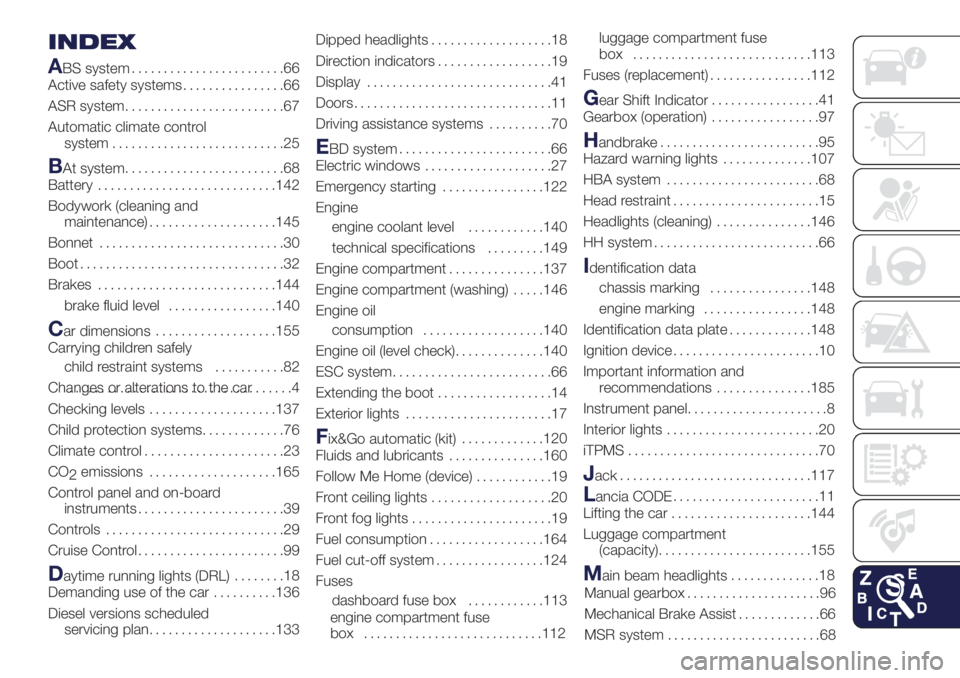
INDEX
A
BS system........................66
Active safety systems................66
ASR system.........................67
Automatic climate control
system...........................25
BAt system.........................68
Battery............................142
Bodywork (cleaning and
maintenance)....................145
Bonnet.............................30
Boot................................32
Brakes............................144
brake fluid level.................140
Car dimensions...................155
Carrying children safely
child restraint systems...........82
Changes or alterations to the car...................................4
Checking levels....................137
Child protection systems.............76
Climate control......................23
CO
2emissions....................165
Control panel and on-board
instruments.......................39
Controls............................29
Cruise Control.......................99
Daytime running lights (DRL)........18
Demanding use of the car..........136
Diesel versions scheduled
servicing plan....................133Dipped headlights...................18
Direction indicators..................19
Display.............................41
Doors...............................11
Driving assistance systems..........70
EBD system........................66
Electric windows....................27
Emergency starting................122
Engine
engine coolant level............140
technical specifications.........149
Engine compartment...............137
Engine compartment (washing).....146
Engine oil
consumption...................140
Engine oil (level check)..............140
ESC system.........................66
Extending the boot..................14
Exterior lights.......................17
Fix&Go automatic (kit).............120
Fluids and lubricants...............160
Follow Me Home (device)............19
Front ceiling lights...................20
Front fog lights......................19
Fuel consumption..................164
Fuel cut-off system.................124
Fuses
dashboard fuse box............113
engine compartment fuse
box ............................112luggage compartment fuse
box ............................113
Fuses (replacement)................112
Gear Shift Indicator.................41
Gearbox (operation).................97
Handbrake.........................95
Hazard warning lights..............107
HBA system........................68
Head restraint.......................15
Headlights (cleaning)...............146
HH system..........................66
Identification data
chassis marking................148
engine marking.................148
Identification data plate.............148
Ignition device.......................10
Important information and
recommendations...............185
Instrument panel......................8
Interior lights........................20
iTPMS..............................70
Jack..............................117
Lancia CODE.......................11
Lifting the car......................144
Luggage compartment
(capacity)........................155
Main beam headlights..............18
Manual gearbox.....................96
Mechanical Brake Assist.............66
MSR system........................68